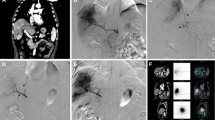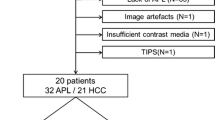Abstract
Purpose
The aim of this study was to evaluate quantitatively arteriovenous shunts in malignant liver tumors by injection of99mTc macroaggregates of albumin (MAA) into the tumor-feeding artery after selective catheterization.
Methods
In 40 patients with malignant liver tumors (33 hepatocellular carcinomas and 7 metastases of colorectal cancer), a mean dose of 200 MBq99mTc MAA was injected arterially during angiography. The embolized area and the lungs were then visualized using a gamma camera. A dedicated computer program calculated pulmonary shunt rates.
Results
The majority of patients (n=30) with hepatocellular carcinoma showed small shunts varying from 0 to 15%; only 3 of these patients had shunts ranging from 18% to 37%. In patients with colorectal carcinoma metastases (n=7) the shunt varied from 0 to 3% (2±1%), probably due to a physiological shunt in normal liver tissue in the embolized area. Importantly, the degree of shunt found bore no correlation to the tumor volume or to the pattern of vascularity on angiography.
Conclusion
Diagnostic angioscintigraphy is a useful tool for pretherapeutic evaluation of the capacity of an individual tumor to retain particles and to measure extratumoral shunting; these are essential for therapy planning, as they can help to increase the safety and effectiveness of embolization.
Similar content being viewed by others
References
Roesler H, Triller J, Baer HU, Geiger L, Beer HF, Becker C, Blumgart LH (1994) Superselective radiombolisation of hepatocellular carcinoma: 5-year results of a prospective study. Nucl Med 33:206–214
Triller J, Rösler H, Geiger L, Baer HU (1994) Methodik der superselektiven Radioembolisation von Lebertumoren mit90Yttrium-Resin-Partikeln. Fortschr Röntgenstr 160:425–431
Mauderly JL, Pickrell JA, Hobbs CH (1973) The effects of inhaled90Y fused clay aerosol on pulmonary function and related parameters of the beagle dog. Radiat Res 56:83–96
Triller J, Baer HU, Geiger L, Kinser J, Rösler H, Blumgart LH (1995) Radioembolization of hepatocellular carcinoma with 90-yttrium resin particles. Eur Radiol (in press)
Becker CD, Rösler H, Demarmels Biasiutti F, Baer HU (1995) Congestive hypersplenism: Treatment by means of radioembolization of the spleen with Y-90. Radiology 195:183–186
Gyves J, Zeissmann HA, Ensminger WD, Niederhuber JE, Keyes JW, Walker S (1984) Definition of hepatic tumor microcirculation by single photon emission computerised tomography (SPECT). J Nucl Med 25:972–977
Blanchard RJ, Grotenhuis I, LaFave JW, Perry JF (1965) Blood supply to hepatic V2 carcinoma implants as measured by radioactive microspheres. Proc Soc Exp Biol Med 118:465–468
Takada T, Ido K, Yuasa Y, et al (1988) Intraarterial digital subtraction with langiography carbon dioxide: Superior detectability of arteriovenous shunting. Cardiovasc Intervent Radiol 11:101–107
Leung WT, Lau WY, Ho SKW, Chan M, Leung NWY, Lin J, Metreweli C, Johnson PJ, Li AKC (1994) Measuring lung shunting in hepatocellular carcinoma with intrahepatic-arterial technetium-99m macroaggregated albumin. J Nucl Med 35:70–73
Ariel IM, Padula G (1982) Treatment of asymptomatic metastatic cancer to the liver from primary colon and rectal cancer by the intraarterial administration of chemotherapy and radioactive isotopes. J Surg Oncol 20:151–156
Biersack HJ, Hansen HH, Kropp J, Winkler C (1986) Perfusionsszintigraphie der Leber mit99mTc-Makro-Albumin-Aggregaten (MAA) bei intraarterieller Chemotherapie von Lebermetastasen: Ergebnisse vor und nach passagerer Leberendarterialisation. Nuc Compact 17:258–260
Ziessmann HA, Thrall JH, Gyves JW, Ensminger WD, Nierderhuber JE, Tuscan M, Walker S (1983) Quantitative hepatic arterial perfusion scintigraphy and starch microspheres in cancer chemotherapy. J Nucl Med 24:871–875
Schubiger PA, Beer H-F, Geiger L, Rösler H, Zimmermann A, Triller J, Mettler D, Schilt W (1991)90Y-Resin particles: Animal experiments on pigs with regard to the introduction of superselective embolization therapy. Nucl Med Biol 18:305–311
Haldemann AR, Rösler H, Noelpp U, Vonlanthen T, Schroth G (1994) Pretherapeutic radioembolization of CNS tumors: Methods, dosimetry and first clinical experience. (abstract) J Nucl Med 35:145P
Author information
Authors and Affiliations
Rights and permissions
About this article
Cite this article
Walser, R.H., Haldemann, A.R., Rösler, H. et al. Diagnostic angioscintigraphic evaluation of malignant hepatic tumors before catheter embolization: Determination of shunt, flow distribution, and reflux. Cardiovasc Intervent Radiol 19, 77–81 (1996). https://doi.org/10.1007/BF02563897
Issue Date:
DOI: https://doi.org/10.1007/BF02563897




